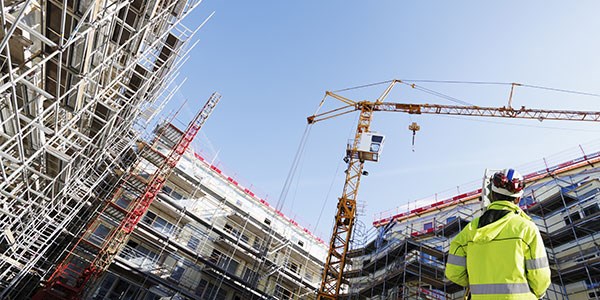An analysis of the most pressing concerns based on insights from 1,000 UK business leaders.


There are a variety of risks and hazards associated with high wind depending on the specific type of work and worksite, but generally, the main risks and hazards include:
Once you have identified the risks and potential hazards, you can begin to take precautions to make working in high winds as safe as possible.
One of the main hazards presented by high winds is that they cause objects to be lifted and blown around, which can severely injure workers and members of the general public. The image below shows a scaffold that blew over in Brighton in 2012 - luckily nobody was on it and nobody was passing by at the time, but it caused major damage to parked cars.
As another example, a wind-related disaster happened in 2017 when Storm Doris brought winds of up to 94mph to the UK and the falling debris killed or injured multiple people.
In order to avoid tragic accidents like these, ensure that every single object and piece of equipment, from cladding to scaffolding, has been properly secured. Thoroughly check them even if they look as though they are fixed. After all, strong winds can even uproot trees.
Weather is an important factor when it comes to dictating what tasks can or cannot be done on particular days. Make sure that you stay up to date with weather reports to make conditions safe for your workers. You can either check weather reports, the internet and apps or invest in battery-powered weather radios, which continually broadcast weather information specific to your area. Avoid certain tasks, such as working at heights and lifting heavy objects. If possible, always try and take the tasks indoors where it will be safer.
If weather reports indicate highly dangerous and strong gales, then cease all outdoor work immediately. The wind makes it more difficult to hear so workers might not hear vehicles coming towards them and it could even damage their hearing. Plus, the disrupted centre of gravity and the speed of the winds will not only make it difficult for machinery to be operated and dangerous for the workers, but it may also damage the equipment.
The wind can easily blow objects away, particularly light objects such as hard hats and sheeting. It becomes even more dangerous when high winds are involved because they can blow heavier objects such as machinery or even trucks (though, hopefully, your site will be closed by this point).
Ensure that you or other workers never attempt to pick up, catch or adjust dropped or falling objects, even if they are light items such as hats and jackets. In that second that you are distracted, you may miss something flying towards you or lose your balance on an elevated surface and risk injuries (or worse) due to falling.
For large but lightweight items, such as damp proof membranes, tarpaulins and other sheeting, ensure everyone involved is reminded to let go if a gust gets up - they can be enormous wind traps. Even the most experienced site worker's instinct may be to keep hold of a rogue ground sheet, but this can result in a strained or dislocated shoulder - or worse if they are picked up off the ground.
Your workers should already be wearing the appropriate safety gear and equipment, but this becomes even more vital in dangerous weather conditions. Anyone who is working at height should be wearing safety harnesses that are securely fastened. Strong winds can blow people working at height to the side or even off the equipment, which makes it even more important for secured safety harnesses. Although if the wind is strong enough to blow a man off a roof, he shouldn't really be on that roof.
Wind also lifts dust and debris, which can easily cause injury. Ensure your workers are always wearing the necessary outdoor safety items such as eye protection and hard hats as well as ensuring your site is dampened down during dry spells in order to minimise dust in the air.
From simple phone-based advice to bespoke consultancy, packaged services, and training, we can provide advice and services that could make a real difference to your organisation. We do this in a way which links your legal obligations to your insurers’ expectations – affordably, accurately, and sustainably.
To contact our friendly team about any of the content in this article, or how we can help you with your hazards and risks associated with high wind within the construction sector, please call 0800 612 3635.
The sole purpose of this article is to provide guidance on the issues covered. This article is not intended to give legal advice, and, accordingly, it should not be relied upon. It should not be regarded as a comprehensive statement of the law and/ or market practice in this area. We make no claims as to the completeness or accuracy of the information contained herein or in the links which were live at the date of publication. You should not act upon (or should refrain from acting upon) information in this publication without first seeking specific legal and/or specialist advice. Arthur J. Gallagher Insurance Brokers Limited accepts no liability for any inaccuracy, omission or mistake in this publication, nor will we be responsible for any loss which may be suffered as a result of any person relying on the information contained herein.